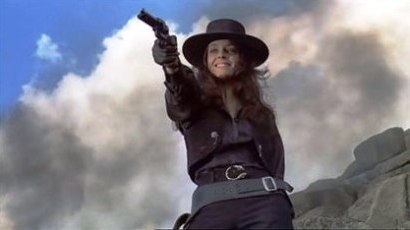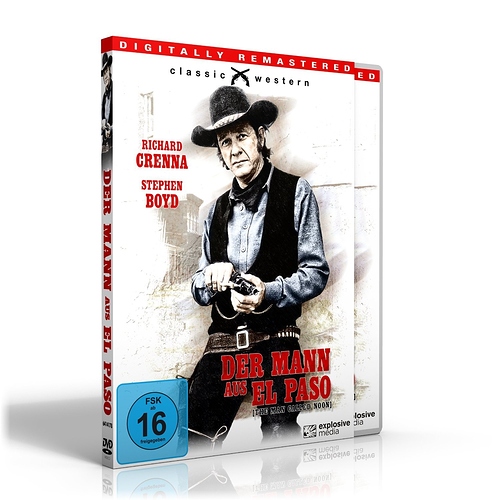Finally had the time to watch A man called Noon
By norm I’m always suspicious about Euro westerns directed by non-Italian (or US) directors, even more if made already in 1973, so my initial approach to the film was not to expect much.
So and starting by the end, it wasn’t as bad as I expected, a 3 out of 5.
Collison, a British director with somehow a similar career path to also British Terence Young, another, by 1973 he had already done some of his best or most successful films, so we can say he was an experienced director. Strangely the film looks very academic, almost like if it was made by a rookie director, with a how to make a western in ten steps feeling. This can be explained by the fact that it was Collison first western.
Making slow paced westerns, isn’t really the easiest way to go, Cemetery without crosses it’s not, by I liked the thriller aspect of the story, and you could notice a very British feeling in that part. Yes the director seemed a bit lost not really knowing what style to follow, but that was the most negative aspect of the film, the story is a bit confusing and not easy to follow, but that end ups to be one cohesion factor for the film, among so much diversity.
The acting was pretty much OK, I’m not that used to Crenna, but he looks solid in the lead, Boyd had past his prime at the time the film was made, but I did like him in the most SW type of character from the film, also liked the bad guy character actor Farley Granger. Schiafinno with Sambrell help to rescue the SW feeling, along with the locations. They seemed to choose a lot of recognizable places, but they were used to good effect.
OK not a great one, but I didn’t find it boring, with so many different particularities it ended up to be different, not good not bad, but different.
After a couple of years I went back to this movie (I think I watched it for the third time)
It’s not very good, but the premise is so intruiging, that every time I watch it, I expect it to be better than I remembered it to be
Again my conclusion must be that it’s just an average movie with some good ideas and two beautiful women

[size=12pt]http://www.spaghetti-western.net/index.php/The_Man_Called_Noon_(Film_Review)[/size]
Just viewed this one again via the French dvd this time which has english audio. Much better audio and sounds than the U.K dvd, and possibly better picture quality aswell. When I watch Crenna alot of the times its as though he acts with a style where he seems to take the piss…I am acting in this film but really I am not sure whether the film is any good or not :D. Anyway I like the style :). And its done to good effect here, and possibly my favourite Crenna starring role film. The ladies as already mentioned are lovely. Some interesting and silly things at the end of the film. The big rock coming down is rather tackly done. The scenes with the horses dragging the fireballs is one that you do not see much in westerns. But do like the mood in this one, and probably because I have viewed the film so many times the plot is straight forward for me.
Just watched the German DVD. Quite a movie. A bit unbalanced and definitely not perfect, but quite ambitious
Boring? In places.
Ugly looking images and shitty colors? Absolutely not, visually it is a rather sophisticated movie. But…
… scherpschutter is right, you can have too much of a good thing.
The movie cannot be classified as spaghetti western, so if you have no objections I’ll edit the category of this topic.
Yes, no SW for me too.
But it is visually a very bad film, far from sophisticated looking.The directing is terrible, and it is mostly boring, or in places, too many places in that case.
A merely okay semi-spaghie that gets goddamn dreadful towards the end. It’s incredible how quickly it turns to shit after its fairly tolerable first half. Some directing and editing choices are questionable, especially during the final shootouts and the climax involving the rock tumbling down (hilarious). It gets some stuff right for the most part and then… not so right.
Unfortunately Collinson was obsessed with weird camera angles and most of his films are marred by this. You spend most of your time peering around objects placed between the actors and the camera. It lacks a spaghetti feel, but is worth seeing for the performances and some decent action scenes. The best thing in it is Bacalov’s score.
I just watched The Man Called Noon for the first time and my DVD had English subtitles so the plot was easy to follow and was not that bad.
But the music by Bacalov was really HORRIBLE in many scenes destroying any spaghetti western feeling that otherwise was rare.
The first 50 minutes felt pure American style or it least not SW. I don’t know exactly why since the slow pace is no good criterium, but maybe they talk slow and with typical American accent and without all the Spanish/Mexican characters/accents I am used to since that type of characters were missing.
Maybe Italian and English actors talk much faster so also the dubbing is fast ?
The last 45 minutes was slightly more entertaining.
In spite of good visual quality and many well known Spanish locations (with all 3 Tabernas Western towns) this film is maybe just marginally better IMO than Red Sun (5/10) which also has a slow pace in slightly or little less pronounced American style.
So a 5/10 seems appropriate but with better music I might have rated it 6/10. I will probably not rewatch it within reasonable time.
This movie’s page in the database has been updated to the new layout. Let us know if corrections are in order, or if you can contribute anything.
Just saw this again after about 12 years - better than I remembered and I thought the best of Brit producer Euan Lloyd’s 3 Louis L’Amour westerns. I have the novel to go through yet. This started filming in September 1972 (based on production list in a UK trade periodical).
I found the plot overengineered and includes various names mentioned we never see, like the dead lawyer, and is a bit difficult to follow. Patty Shepherd and Farley Granger as the main villains don’t turn up until the hour mark and I thought they should have appeared earlier, especially Shephard. Confusingly at times the bad guys are trying to kill Noon and at other times want to capture him to discover where he has hidden the gold. Make your minds up!! That rock rolling scene was just stupid - there is a similar scene in the American Elvis western Charro, involving an escaping cannon which rolls about 200 yards and kills someone. I agree with poster who said Crenna is too old - I don’t think L’Amour gives him an age (which he might not do if he was angling to sell the rights to a film company).
I saw the UK Odeon DVD and agree that a bit of sound muffling at the beginning especially. Some bad day-for-day photography where you can see blue sky above actors’ heads. The Odeon DVD is the USA print as it starts off and ends with a National General ident. The film suffered several cuts from the BBFC to get an AA rating in 1973 including a ‘reduction’ applied to the shots of falling horses towards the end. The DVD being the USA print, all of the UK cinema cuts have been restored and the BBFC did not cut it for DVD release. Although quite graphic, the horsefalls look like trained stunts and not wire-trips which would be cut by the BBFC. For cinema the BBFC also reduced Henecker’s death and Jose Caneljas’s death.
The Italian censors gave it a 14 and over rating due to violence which seems quite harsh to me - Those Dirty Dogs, passed a couple of months earlier, got an unrestricted rating despite similar violence and a scene in which a woman’s blouse is ripped open. Dead Men Ride which has nudity and violence got an unrestricted rating also.
Read the L’Amour novel on which this is based.
The plot is pretty much the same although the film has made simplifications, especially at the end.
• Rimes has a much reduced role in the novel and after delivering Jonas to the Rafter D is largely missing until the last 10 pages in which he reveals himself to be a Wells Fargo agent. So in the novel Jonas does all the investigating himself.
• The last section is far more complicated in the novel (over complicated). Jonas and Fan escape the cabin through a tunnel in in the hill but later find a second cabin, hidden in a tree ( there is a second Mexican in a farm as well who directs them and the gold is in this second cabin). Jonas kills a few bad guys at both cabins but then he and Fran and a character missing from the film hightail it to the train where they are ambushed not once but twice as the baddies have split into two groups. So two of everything.
• Because Rimes has a much smaller role and the ending is over complicated the novel has several extra characters who help Jonas in the last fifty pages who have been eliminated from the film.
• The plot is a bit easier to understand in the novel but still has loads of holes such as why Jonas has apparently made all those trips from the cabin to El Paso and why the Judge befriends Jonas and gives away half of the plot when he is a bad guy. I also didn’t understand why the gold was hidden as musket balls rather than put in a bank in the first place as Jonas tries to do when he remembers where it is. L’Amour also does his usual thing of giving some kind of detailed backstory to several henchmen who are then killed immediately.
The film is wrecked by director Peter Collinson’s obsession with weird camera angles. The best and most memorable thing in it is Luis Enrique Bacalov’s score.
